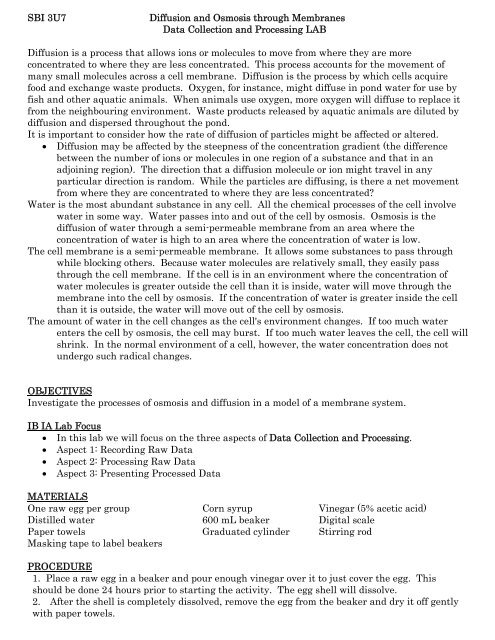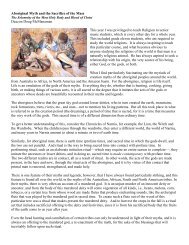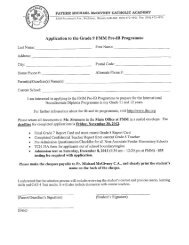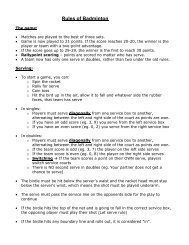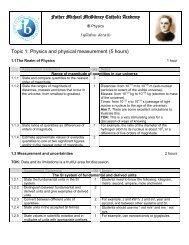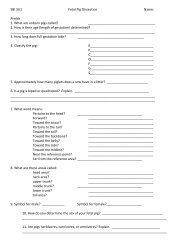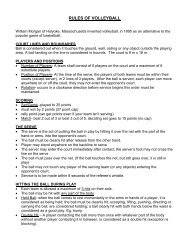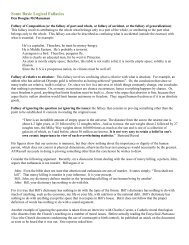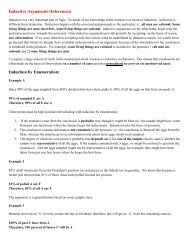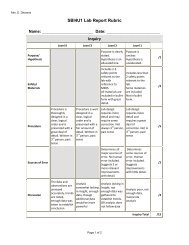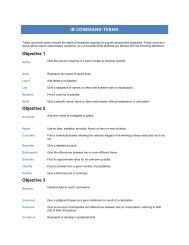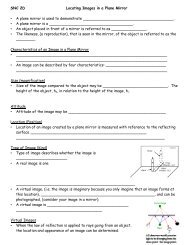DIffusion & Osmosis Lab
DIffusion & Osmosis Lab
DIffusion & Osmosis Lab
- No tags were found...
Create successful ePaper yourself
Turn your PDF publications into a flip-book with our unique Google optimized e-Paper software.
SBI 3U7Diffusion and <strong>Osmosis</strong> through MembranesData Collection and Processing LABDiffusion is a process that allows ions or molecules to move from where they are moreconcentrated to where they are less concentrated. This process accounts for the movement ofmany small molecules across a cell membrane. Diffusion is the process by which cells acquirefood and exchange waste products. Oxygen, for instance, might diffuse in pond water for use byfish and other aquatic animals. When animals use oxygen, more oxygen will diffuse to replace itfrom the neighbouring environment. Waste products released by aquatic animals are diluted bydiffusion and dispersed throughout the pond.It is important to consider how the rate of diffusion of particles might be affected or altered.Diffusion may be affected by the steepness of the concentration gradient (the differencebetween the number of ions or molecules in one region of a substance and that in anadjoining region). The direction that a diffusion molecule or ion might travel in anyparticular direction is random. While the particles are diffusing, is there a net movementfrom where they are concentrated to where they are less concentrated?Water is the most abundant substance in any cell. All the chemical processes of the cell involvewater in some way. Water passes into and out of the cell by osmosis. <strong>Osmosis</strong> is thediffusion of water through a semi-permeable membrane from an area where theconcentration of water is high to an area where the concentration of water is low.The cell membrane is a semi-permeable membrane. It allows some substances to pass throughwhile blocking others. Because water molecules are relatively small, they easily passthrough the cell membrane. If the cell is in an environment where the concentration ofwater molecules is greater outside the cell than it is inside, water will move through themembrane into the cell by osmosis. If the concentration of water is greater inside the cellthan it is outside, the water will move out of the cell by osmosis.The amount of water in the cell changes as the cell's environment changes. If too much waterenters the cell by osmosis, the cell may burst. If too much water leaves the cell, the cell willshrink. In the normal environment of a cell, however, the water concentration does notundergo such radical changes.OBJECTIVESInvestigate the processes of osmosis and diffusion in a model of a membrane system.IB IA <strong>Lab</strong> Focus In this lab we will focus on the three aspects of Data Collection and Processing. Aspect 1: Recording Raw Data Aspect 2: Processing Raw Data Aspect 3: Presenting Processed DataMATERIALSOne raw egg per group Corn syrup Vinegar (5% acetic acid)Distilled water 600 mL beaker Digital scalePaper towels Graduated cylinder Stirring rodMasking tape to label beakersPROCEDURE1. Place a raw egg in a beaker and pour enough vinegar over it to just cover the egg. Thisshould be done 24 hours prior to starting the activity. The egg shell will dissolve.2. After the shell is completely dissolved, remove the egg from the beaker and dry it off gentlywith paper towels.
3. Place the egg on the balance, determine and record the dry mass of the egg.4. A corn syrup solution of assigned concentration will be made in a beaker:Group 1- 0% solution: 250 mL of waterGroup 2-10% solution: 25 mL corn syrup, 225 mL waterGroup 3-20% solution: 50 mL corn syrup, 200 mL waterGroup 4-30% solution: 75 mL corn syrup, 175 mL waterGroup 5-50% solution: 125 mL corn syrup, 125 mL waterGroup 6-70% solution: 175 mL corn syrup, 75 mL water5. Place the egg in the corn syrup solution and leave for 24 hours.6. Remove the egg from the corn syrup solution and dry off the outside of the egg with papertowels.HYPOTHESIZE: Predict what you think will happen during the experiment. (Think about whichbags will lose water and which will gain water.) Note your hypothesis in the passive voice, e.g.:“This will occur if…” NOT “I think this will occur…”7. Place the egg on the balance, determine and record the dry mass of the egg..DATA COLLECTION AND PROCESSING ASPECT 1: Recording Raw DataCreate a formal DATA TABLE in which to present the raw, unmodified data you collected. Be sure yourtable:o Is easy to understando Has a specific titleo Tables are titled in sequential order as “Table 1: title.” “Table 2: title”o Has column headingso Includes the unit of measurement of the MV and RV (always in metric units)o Includes the measurement uncertainty of the measurement tools used (or, if the data was a count,indicates that “counts have no measurable uncertainty”). Uncertainly is usually stated in a columnheading or as a footnote at the bottom of the table.o Has a consistent and correct number of digits for each measuremento Has decimal points aligning down a column (if applicable) and numbers centered in the columno Indicates which data was collected by which student IF the data was collected and pooled acrossmultiple students.Your report must include QUALITATIVE DATA. This might be a paragraph in which you describe thequalitative observations and results in general or be specific qualitative data for each trial that is presentedin table form.
LAB DRAWINGS are considered data by the IB Organization. Not all labs will include a lab drawing.However, when included, please be sure your lab drawings:o Are done with a sharp pencil line on white, unlined paper.o Have the drawing occupy at least half a page, centered on the page.o Include labels written off straight, horizontal lines to the right of the side of the drawing. The labelsshould form a vertical list.o Are accurate. Draw what you see; as you see it, not what you imagine should be there.o Include a title that states what has been drawn and what lens power it was drawn under. The titlemust be informative, centered, and larger than other text.o Has a scale that indicates how many times larger the drawing is compared to life size and a scale linethat indicates relative size.o Note that photographs are also accepted – must include labels, title and description.AS A CLASS: Design a data table… what should we include on our raw data table? Don’t forget units anduncertainties.8. Calculate the change in mass and percent change in mass. To calculate: percent change inmass = (final mass – initial mass)/initial mass. Than multiply by 100.9. Gather the data from the other groups in the class and find the class average for each baggie.DATA COLLECTION AND PROCESSING ASPECT 2: Processing Raw DataSTATISTICS are useful mathematical tools which are used to analyze data. Common statistics used inbiology are:o Meano Rangeo Mediano Percent changeo Standard deviation (to determine amount of variation around a mean)o T-test (to compare two means to determine if they are statistically different from each other). When at-test is calculated, you must indicate the significance level at which your critical T value isdetermined (we typically use the 95% confidence interval, 0.05).o Chi-square (to determine if “observed” results are significantly different from “expected” results)o Correlation coefficient (to determine the extent two variables are related to each other).Use only the statistical tests appropriate to investigate and address your problem question.For each statistic you calculate, you must EXPLAIN WHY YOU ELECTED TO DO THAT CALCULATION.What does the calculation tell you about the data?10. Construct a graph showing the percent change in mass versus the concentration of cornsyrup.Graph the results for both your individual data and class average on a graph. The independentvariable is on the X axis, and the dependent variable is on the Y axis.DATA COLLECTION AND PROCESSING ASPECT 3: Presenting Processed DataShow an EXAMPLE CALCULATION for each statistic you calculate. Use plenty of room; make sure they arelabeled, are clear and are legible. Show the units of measurements in all calculations. Pay attention to thenumber of digits! Don’t lose accuracy by carelessly rounding off. Round only at the end of a calculation. Donot truncate.Present your data processing results in a TABLE. The initial raw data and the processed (calculated) datamay be shown in one table provided they are clearly distinguishable. Be sure your processed data table:o Is easy to understando Has a specific titleo Has column headingso Includes the unit of measuremento Has a consistent and correct number of digits for each measurement (to the same precision as yourraw data)
oHas decimal points aligning down a column (if applicable) and numbers centered in the columnYou must also present your results in a GRAPH. [See attachment on webpage for using Excel to draw graphs]o Use the correct type of graph for the type of data you are presenting.o Graphs must be clear and easy to understand. Please avoid “creative” or “funny” coloring of graphs.o Graphs need to have appropriate scales, labeled axes with units, and accurately plotted data points.o Graphs are titled in sequential order as “Figure 1: title.” “Figure 2: title”o If necessary, add smooth lines or curves to show the overall trend of the data.o If a mean is calculated, only graph the mean, not all data points. When a mean is graphed, itsassociated standard deviation error bar must also be included (and labeled as such).o Legends (keys) are not always necessary. Delete “series 1” and “series 2” boxes from graphs createdin Excel.ANALYSIS OF RESULTS1. Explain the relationship between the change in mass and the concentration of corn syrup in the beaker.2. Was your group’s corn syrup solution hypotonic, hypertonic, or isotonic? Explain how you know.3. Why did you calculate the percent change in mass rather than simply using the change in mass?4. A dialysis bag is filled with distilled water and then placed in a sucrose solution. The bag's initial mass is 20 g, and itsfinal mass is 18 g. Calculate the percent change of mass, showing your calculations.5. What concentration of corn syrup would be the equilibrium point for the egg (isotonic)? Use your graph to interpolatethis point.
IB RUBRICAdapted from <strong>Lab</strong>: Diffusion and <strong>Osmosis</strong>. www.biologycorner.comAdapted from Vernier Biology <strong>Lab</strong>: Diffusion through MembranesYour task:1. Title of <strong>Lab</strong>2. Hypothesis3. Data Collection and processing:a. Aspect 1i. Raw Data Tableii. Qualitative Observationsiii. <strong>Lab</strong> drawingsb. Aspect 2i. Mean, standard deviation processing for your raw dataii. Explain why you used which test (t-test, Chi square test)c. Aspect 3i. Present processed data in a proper tableii. Show at least one calculation for each statistical analysis you performediii. Graph – computer generated (Excel): ‘Percent change in mass vs. concentration ofcorn syrup’4. Analysis of Results – Answer questions above5. You will be evaluated on the completion and correctness of the DCP – see rubric above.DUE DATE: ____________________________


